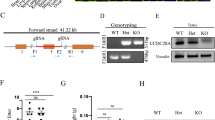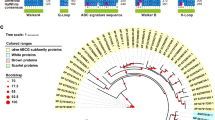Abstract
When eggs from the Chinese tetraploid loach that had 100 chromosomes were fertilized with UV-irradiated sperm, we obtained viable gynogenetic progeny without any additional treatment for the duplication of maternal chromosomes, which survived beyond first feeding towards adult stage of development. Gynogenetic progeny were determined to be diploid since they possessed 50 chromosomes, along with two chromosomes bearing nucleolar organizing regions (NORs), detected by silver nitrate staining (Ag-NORs), chromomycin-A3 (CMA3)-positive sites and fluorescence in situ hybridization (FISH) signals for rDNA loci. In contrast, when gynogens were induced using eggs from diploid loach fertilized by UV-irradiated sperm, but without chromosome doubling, we found that all resultant progeny were non-viable haploid gynogens with 25 chromosomes, along with one NOR-bearing chromosome detected by Ag-NORs, CMA3 and FISH. These observations demonstrate the true genetic tetraploid nature of the Chinese loach possessing 100 chromosomes, and the potential use of this tetraploid as a source of functional diploid gametes for further ploidy manipulation experiments.



Similar content being viewed by others
References
Arai K (2000) Chromosome manipulation in aquaculture: recent progress and perspective. Suisanzoshoku 48:295–303
Arai K (2001) Genetic improvement of aquaculture finfish species by chromosome manipulation techniques in Japan. Aquaculture 197:205–228
Arai K (2003) Genetics of the loach, Misgurnus anguillicaudatus: recent progress and perspective. Folia Biol (Krakow) 51:107–117
Arai K, Matubara K, Suzuki R (1991a) Karyotype and erythrocyte size of spontaneous tetraploidy in the loach Misgurnus anguillicaudatus. Nippon Suisan Gakkaishi 57:2167–2172
Arai K, Matubara K, Suzuki R (1991b) Chromosomes and developmental potential of progeny of spontaneous tetraploid loach Misgurnus anguillicaudatus. Nippon Suisan Gakkaishi 57:2173–2178
Arai K, Masaoka T, Suzuki R (1992) Optimum condition of UV ray irradiation for genetic inactivation of loach eggs. Nippon Suisan Gakkaishi 58:1197–1201
Arai K, Matsubara K, Suzuki R (1993) Production of polyploids and viable gynogens using spontaneously occurring tetraploid loach, Misgurnus anguillicaudatus. Aquaculture 117:227–235
Arai K, Ikeno M, Suzuki R (1995) Production of androgenetic diploid loach Misgurnus anguillicaudatus using spermatozoa of natural tetraploids. Aquaculture 137:131–138
Arai K, Taniura K, Zhang Q (1999) Production of second generation progeny of hexaploid loach. Fish Sci 65:186–192
Arai K, Sakao S, Fujimoto T, Yamaha E (2010) Cutting edge of chromosome manipulation for aquaculture and conservation of salmonids. Natl Taiwan Mus Spec Publ 14:49–52
Chourrout D (1982) Gynogenesis caused by ultraviolet irradiation of salmonid sperm. J Exp Zool 223:175–181
Chourrout D, Chevassus B, Herioux F (1980) Analysis of an Hertwig effect in the rainbow trout (Salmo gairdneri Richardson) after fertilization with gamma-irradiated sperm. Reprod Nutr Dev 20(3A):719–726
Chourrout D, Chevassus B, Krief F, Happe A, Burger G, Renard P (1986) Production of second generation triploid and tetraploid rainbow trout by mating tetraploid males and diploid females—potential of tetraploid fish. Theor Appl Genet 72:193–206
Fujimoto T, Sakao S, Yamaha E, Arai K (2007) Evaluation of different doses of UV irradiation to loach eggs for genetic inactivation of the maternal genome. J Exp Zool Part A 307:449–462
Fujimoto T, Yasui GS, Hayakawa M, Sakao S, Yamaha E, Arai K (2010) Reproductive capacity of neo-tetraploid loaches produced using diploid spermatozoa from a natural tetraploid male. Aquaculture 308:S133–S139
Howell WM, Black DA (1980) Controlled silver-staining of nucleolus organizer regions with a protective colloidal developer: a 1-step method. Experientia 36:1014–1015
Inokuchi T, Abe S, Yamaha E, Yamazaki F, Yoshida MC (1994) BrdU replication banding studies on the chromosomes in early embryos of salmonid fishes. Hereditas 121:255–265
Kurokura H, Hirano R, Tomita M, Iwahashi M (1984) Cryopreservation of carp sperm. Aquaculture 37:267–273
Kusunoki T, Arai K, Suzuki R (1994) Production of viable gynogens without chromosome duplication in the spinous loach Cobitis biwae. Aquaculture 119:11–23
Levan A, Fredga K, Sandberg AA (1964) Nomenclature for centromeric position on chromosomes. Hereditas 52:201–220
Li Y-J, Yin J, Wang J-B, Yuan X, Wei J, Sun X-W, Arai K (2008) A study on the distribution of polyploidy loaches in China. Nippon Suisan Gakkaishi 74:177–182
Li Y-J, Tian Y, Zhang M-Z, Tian P-P, Yu Z, Abe S, Arai K (2010) Chromosome banding and FISH with rDNA in the diploid and tetraploid loach Misgurnus anguillicaudatus. Ichthyol Res 57:358–366
Liu S, Liu Y, Zhou G, Zhang X, Luo C, Feng H, He X, Zhu G, Yang H (2001) The formation of tetraploid stocks of red crucian carp × common carp hybrids as effect of interspecific hybridization. Aquaculture 192:171–186
Matsubara K, Arai K, Suzuki R (1995) Survival potential and chromosomes of progeny of triploid and pentaploid females in the loach, Misgurnus anguillicaudatus. Aquaculture 131:37–48
Morishima K, Horie S, Yamaha E, Arai K (2002) A cryptic clonal line of the loach Misgurnus anguillicaudatus (Teleostei: Cobitidae) evidenced by induced gynogenesis, interspecific hybridization, microsatellite genotyping and multilocus DNA fingerprinting. Zool Sci 19:565–575
Nagy A, Rajki K, Horvath L, Csanyi V (1978) Investigation on carp Cyprinus carpio L. gynogenesis. J Fish Biol 13:215–224
Nam YK, Choi GC, Park DJ, Kim DS (2001) Survival and growth of induced tetraploid mud loach. Aquacult Int 9:6–11
Ojima Y, Takai A (1979) The occurrence of spontaneous polyploidy in the Japanese common loach, Misgurnus anguillicaudatus. Proc Japan Acad 55B:487–491
Onozato H (1982) The “Hertwig effect” and gynogenesis in chum salmon Oncorhynchus keta eggs fertilized with 60Co gamma-ray irradiated milt. Bull Jpn Soc Sci Fish 48:1237–1244
Onozato H, Yamaha E (1983) Induction of gynogenesis with ultraviolet rays in four species of salmoniformes. Bull Jpn Soc Sci Fish 49:693–699
Sakao S, Fujimoto T, Kimura S, Yamaha E, Arai K (2006) Drastic mortality in tetraploid induction results from the elevation of ploidy in masu salmon Oncorhynchus masou. Aquaculture 252:147–160
Schweizer D (1976) Reverse fluorescent chromosome banding with chromomycin and DAPI. Chromosoma 58:307–324
Schweizer D, Ambros P, Andrle M (1978) Modification of DAPI banding on human chromosomes by prestaining with a DNA-banding oligopeptide antibiotic, distamycin A. Exp Cell Res 111:327–332
Suzuki R, Yamaguchi M (1975) Influence of water temperature on inducing spawning by hormone injection in the loach, cyprinid fish. Suisanzoshoku 22:135–139
Suzuki R, Oshirao T, Nakanishi T (1985) Survival, growth and fertility of gynogenetic diploids induced in the cyprinid loach, Misgurnus anguillicaudatus. Aquaculture 48:45–55
Yasui GS, Fujimoto T, Arai K (2010) Restoration of the loach, Misgurnus anguillicaudatus, from cryopreserved diploid sperm and induced androgenesis. Aquaculture 308:S140–S144
Zhang Q, Arai K (1996) Flow cytometry for DNA contents of somatic cells and spermatozoa in the progeny of natural tetraploid loach. Fish Sci 62:870–877
Zou S, Li S, Cai W, Zhao J, Yang H (2004) Establishment of fertile tetraploid population of blunt snout bream (Megalobrama amblycephala). Aquaculture 238:155–164
Acknowledgments
This study was supported in part by Grants-in-Aid for Scientific Research (B) (No. 21380114) from the Japan Society for the Promotion of Science (JSPS) to Katsutoshi Arai and by the Ronpaku (Dissertation Ph.D.) Program (CSC-10610) from JSPS to Ya-Juan Li.
Author information
Authors and Affiliations
Corresponding author
Rights and permissions
About this article
Cite this article
Li, YJ., Yu, Z., Zhang, MZ. et al. Induction of viable gynogenetic progeny using eggs and UV-irradiated sperm from the Chinese tetraploid loach, Misgurnus anguillicaudatus . Aquacult Int 21, 759–768 (2013). https://doi.org/10.1007/s10499-012-9551-3
Received:
Accepted:
Published:
Issue Date:
DOI: https://doi.org/10.1007/s10499-012-9551-3




